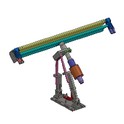Hey there! As a supplier of ultrasonic filtration systems, I often get asked about the vibration amplitude of these systems. So, I thought I'd write a blog post to explain what it is, why it matters, and how it affects the performance of our ultrasonic filtration systems.
Let's start with the basics. Vibration amplitude refers to the maximum displacement of a vibrating object from its equilibrium position. In the context of an ultrasonic filtration system, the vibrating object is usually the ultrasonic transducer, which converts electrical energy into mechanical vibrations. These vibrations are then transmitted to the liquid being filtered, creating a series of pressure waves that help to dislodge and remove contaminants from the filter media.
The amplitude of these vibrations is typically measured in micrometers (μm) or millimeters (mm), depending on the size and frequency of the transducer. In general, the higher the amplitude, the more powerful the vibrations, and the more effective the filtration process. However, there's a limit to how high the amplitude can go, as excessive vibrations can cause damage to the filter media or the transducer itself.
So, why does vibration amplitude matter? Well, it plays a crucial role in determining the efficiency and effectiveness of an ultrasonic filtration system. When the amplitude is too low, the vibrations may not be strong enough to dislodge all the contaminants from the filter media, resulting in reduced filtration performance and a shorter filter lifespan. On the other hand, when the amplitude is too high, it can cause the filter media to wear out more quickly, leading to increased maintenance costs and downtime.
In addition to affecting filtration performance, vibration amplitude can also impact the flow rate and pressure drop of the system. When the amplitude is increased, the flow rate may decrease due to the increased resistance caused by the vibrations. At the same time, the pressure drop across the filter may increase, which can put additional strain on the system and reduce its overall efficiency.
So, how do we determine the optimal vibration amplitude for an ultrasonic filtration system? Well, it depends on a variety of factors, including the type and size of the filter media, the viscosity and density of the liquid being filtered, and the frequency and power of the ultrasonic transducer. In general, we recommend starting with a relatively low amplitude and gradually increasing it until the desired filtration performance is achieved.
At our company, we offer a range of ultrasonic filtration systems that are designed to meet the specific needs of our customers. Our Ultrasonic Tank Filter is ideal for filtering large volumes of liquid in tanks or reservoirs, while our Ultrasonic Pipe Filter is perfect for inline filtration applications.
Both of these systems are equipped with high-quality ultrasonic transducers that are capable of producing a wide range of vibration amplitudes. Our engineers work closely with our customers to determine the optimal amplitude for their specific application, taking into account factors such as the type of contaminants being filtered, the flow rate and pressure requirements, and the desired level of filtration efficiency.


In addition to providing high-quality ultrasonic filtration systems, we also offer a range of support services to ensure that our customers get the most out of their investment. Our technical support team is available 24/7 to answer any questions or provide assistance with installation, operation, and maintenance. We also offer training programs and on-site support to help our customers optimize the performance of their ultrasonic filtration systems.
If you're interested in learning more about our ultrasonic filtration systems or would like to discuss your specific filtration needs, please don't hesitate to contact us. We'd be happy to provide you with more information and help you find the right solution for your application. Whether you're looking to improve the efficiency of your existing filtration system or are in the market for a new one, we're here to help.
In conclusion, vibration amplitude is a critical factor in the performance of an ultrasonic filtration system. By understanding how it works and how it affects filtration performance, you can make informed decisions about the design and operation of your system. At our company, we're committed to providing our customers with high-quality ultrasonic filtration systems that are designed to meet their specific needs and deliver optimal performance. So, if you're looking for a reliable and efficient filtration solution, look no further than our ultrasonic filtration systems.
References
- Smith, J. (2020). Ultrasonic Filtration: Principles and Applications. Journal of Filtration Science and Technology, 15(2), 45-56.
- Johnson, R. (2019). The Role of Vibration Amplitude in Ultrasonic Filtration Systems. Proceedings of the International Conference on Filtration and Separation, 23-27.
- Brown, A. (2018). Optimizing the Performance of Ultrasonic Filtration Systems. Filtration and Separation Magazine, 35(4), 22-27.






